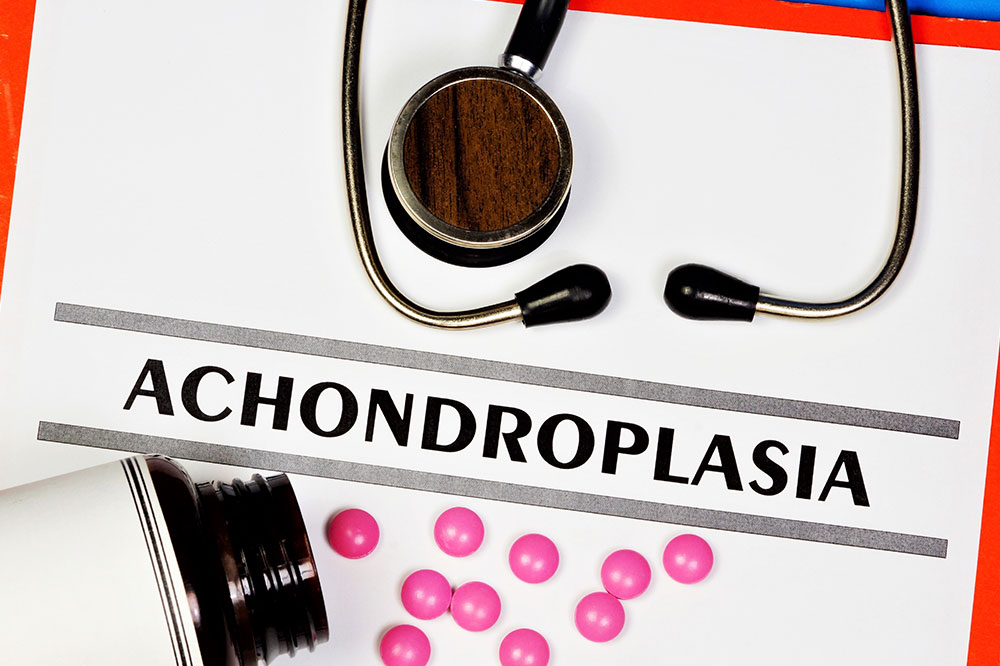
Achondroplasia – Symptoms, causes, and management
Achondroplasia is a genetic disorder that affects bone growth and development. A mutation in the FGFR3 gene, which regulates bone growth, causes this form of dwarfism. A person only needs to inherit one copy of the mutated gene from one parent to develop the condition. The mutation follows an autosomal dominant inheritance pattern. Approximately 1 in 25,000 live births are affected by achondroplasia. This article will explore the achondroplasia causes, symptoms, diagnosis, treatment, and management.
Symptoms of achondroplasia
Short stature is the most prominent symptom of achondroplasia. The arms and legs are short in people with the condition, but the torso is normal-sized. There is also a possibility that they will have a large head with a prominent forehead and a flattened nose bridge.
Other symptoms of achondroplasia include:
Short fingers and toes
Hearing loss due to fluid buildup in the middle ear
Joint problems, such as limited range of motion
Abnormal curvature of the spine (scoliosis)
Breathing problems, especially during sleep
Delayed motor development, such as sitting up, standing, and walking
Causes of achondroplasia
Mutations in the FGFR3 gene is one of the causes of achondroplasia. This gene produces a protein that regulates bone growth. Mutations in the FGFR3 gene cause a defective protein to be produced, resulting in short stature and other physical features associated with achondroplasia.
About 80% of FGFR3 gene mutations occur spontaneously, meaning the mutation is not inherited from either parent. Most of the time, however, the mutation is inherited from a parent with achondroplasia or who carries the mutated gene. The mutation follows an autosomal dominant inheritance pattern, meaning a person only needs one copy of the mutated gene from one parent to develop it.
The offspring of affected parents with one or two copies of the mutated gene are more likely to inherit the mutation. If both parents have achondroplasia, their children will inherit two copies of the mutated gene and are unlikely to survive to term. Each child of a parent with the condition and one without has a 50% chance of inheriting the mutation and developing achondroplasia.
Diagnosis of achondroplasia
Achondroplasia can be diagnosed prenatally through chorionic villus sampling (CVS) or amniocentesis. An FGFR3 mutation can be detected in fetal cells with these tests. Physical examinations and medical histories are typically used to diagnose achondroplasia after birth. The baby’s height will be measured by a doctor and compared to the average height for their age and gender. They will also examine the baby’s head, limbs, and spine for achondroplasia characteristics.
Genetic testing can confirm the presence of the FGFR3 mutation if achondroplasia is suspected. A blood or saliva DNA sample is taken and analyzed to determine if there is a mutation. It is also possible to determine whether a mutation was inherited from a parent or if it occurred spontaneously through genetic testing.
It is important to note that not every case of achondroplasia is diagnosed at birth. Symptoms of achondroplasia may not appear until later in childhood or adolescence in some individuals. However, physical examinations and genetic tests can still be performed in these cases to diagnose the condition.
Treatment of achondroplasia
Currently, there is no cure for achondroplasia, and the main focus of treatment of achondroplasia is to manage symptoms and prevent complications. Treatment options include:
Growth hormone therapy
Bone growth is stimulated by inserting synthetic growth hormones. However, achondroplasia patients do not benefit significantly from it as far as height is concerned.
Limb-lengthening surgery
In this process, bones are broken and stretched to increase their length. However, not everyone is a good candidate for this procedure since it can be painful and risky.
Spinal surgery
As a result, spinal deformities such as scoliosis can be corrected, and pressure on the spinal cord can be relieved.
Ear tube surgery
Ear tube surgery can help alleviate hearing loss caused by middle ear fluid buildup.
Physical therapy
This therapy helps build muscle strength and joint mobility.
Monitoring growth and development, managing complications, and addressing any concerns regarding achondroplasia is essential. In addition to psychological and social support, achondroplasia patients may benefit from assistance in managing the challenges of their condition.
Conclusion
A mutation in the FGFR3 gene is the cause of achondroplasia, interfering with bone growth and development. An achondroplasia diagnosis can be made before or after birth through prenatal and genetic testing. It is possible to improve the quality of life for people who suffer from achondroplasia through early diagnosis and management, even though there is no cure for the disease. Families affected by achondroplasia should receive genetic counseling to better understand the inheritance pattern and potential risks. For achondroplasia treatment to work, it is important that the process is followed properly and that patients take the prescriptive treatment by their doctors seriously. One needs to be patient to understand the changes after/during the process.




